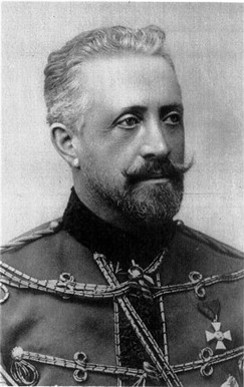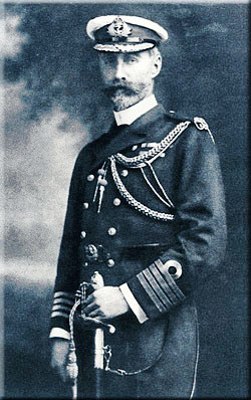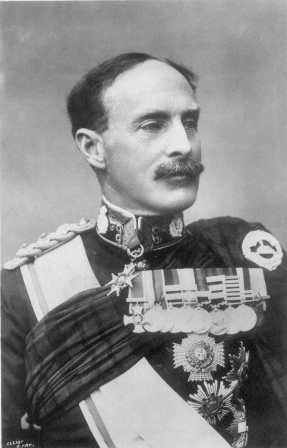Preparations
By Christmas 1914 the western front had developed into static trench warfare following the repulse of the initial German offensive at the battle of the Marne. The Russians, slower to mobilise than their Anglo-French allies, were in trouble following their defeats in East Prussia and the need to cope with advancing Austro-Hungarian armies in the south. The British Expeditionary Force on the western front could do no more than hold on to its positions while new armies were raised and trained in the United Kingdom as the result of Lord Kitchener’s dramatic recruiting drive for volunteers. He had been propelled into the job of War Minister as war broke out in the absence of anyone with the necessary knowledge and influence to be the political chief of the British army. A long-standing national icon whose campaigning days had climaxed in his ruthless termination of the Boer War in 1902, he was unlearned as a politician and soon found himself sitting mute at meetings of the War Council. The War Office, over which he presided, was totally separate from the Admiralty across Whitehall and the absence of any Joint staffs greatly hampered preparations for the impending campaign in the eastern Mediterranean.
Russia declared war on Turkey on 1 November 1914 following a surprise raid by the Turkish fleet, under the command of the German Admiral Souchon and spearheaded by the Goeben and Breslau on the Russian Black Sea ports. Under the terms of their alliance with Russia, Britain and France followed suit five days later. The Sultan proclaimed a Jehad against the western allies, presumably in the hope that it would lead to insurrection in India's Muslim population and mutiny in the predominantly Muslim regiments of the Indian Army (with very few exceptions they remained steadfast and loyal to the King Emperor throughout the war). Moreover, the Hashemite Sharifs of Mecca and Medina also declined to join the Holy War; they had their own agenda which was revealed once Britain's Colonel T E Lawrence had successfully initiated the Arab revolt against the Ottomans.
 Photograph: Grand Duke Nikolay Nikolayevich Romanov of Russia
Photograph: Grand Duke Nikolay Nikolayevich Romanov of Russia
On 2 January 1915 the Grand Duke Nicholas, Russian commander-in-chief, cabled a message to London asking for no more than a 'demonstration' against the Turks as a diversion from their offensive against the Russian army in the Caucasus, which, rashly ordered by Enver Pasha against the advice of Liman von Sanders and his staff, failed miserably in appalling winter conditions. Nevertheless it afforded Churchill and those favouring an indirect approach against the Central Powers and their new ally Turkey the chance to open a new front in the eastern Mediterranean and Aegean. Admiral Carden was ordered by Churchill, despite the growing apprehensions of Fisher ('Damn the Dardanelles, they will be our grave') to plan a full scale naval assault on the Chanak narrows with the aim of entering the Sea of Marmara and placing Constantinople under the guns of the allied fleet. The first phase, starting on 19 February, consisted of the bombardment and neutralisation of the outer forts and batteries at the mouth of the Dardanelles where under four miles separated those at KumKale on the Asiatic and Sedd el Bahr on the European side. Landing parties were sent ashore against growing opposition to complete the destruction of the major emplacements before the batteries were eliminated. All surprise had now been lost and the allies' intentions were clear to the defenders who set about improving the inner defences - thickening the minefields in the approaches to the narrows and upgrading the inner batteries and forts guarding the mile-wide entrance to the Sea of Marmara.
 Photograph: Vice-admiral Sackville Hamilton Carden
Photograph: Vice-admiral Sackville Hamilton Carden
Carden would have known that in 1911 Churchill had stated that it would be impossible to force the Dardanelles with a fleet alone, a view with which Fisher heartily concurred, but Churchill now pressed for a plan for this hazardous operation. Carden informed London that the fleet would make its attempt on 18 March. By this time he was on the verge of nervous collapse; his doubts had communicated themselves to Whitehall and a belated decision was made by Kitchener to assemble a scratch land force to support the naval operations. Fisher, hitherto non-committal, now expressed doubts over the enterprise; he had passed through the Narrows in the 1870s when serving in a visiting squadron and had seen for himself the strength of the batteries even then.
Only five days before the naval attack, General Sir Ian Hamilton, newly appointed commander in chief, was hurriedly briefed by Kitchener and set out for the seat of war, arriving in time to see the fleet repulsed by a combination of well-served land batteries, mobile howitzers and mines; one field of which, laid secretly by night from the steamer Nusret unobserved by the allies, helped to sink three battleships on 18 March; several other capital ships were badly damaged. To Fisher's fury Churchill had sanctioned the deployment to the eastern Mediterranean of the new super-dreadnought Queen Elizabeth whose 15- inch guns were used effectively against the Inner Forts. The fleet was now commanded by Vice Admiral de Robeck, Carden having broken down under mental strain. De Robeck inherited Carden's chief of Staff, the fiery Commodore Roger Keyes, a passionate believer in offensive action who pressed de Robeck to resume the attack, regardless of casualties on the following day, when it might have succeeded as the defenders were demoralised, exhausted and virtually out of ammunition. The admiral, however, declined to attack.
Photograph: General Sir Ian Hamilton.
 Hamilton had watched the naval attack from the light cruiser, HMS Phaeton, that had carried him the length of the Mediterranean at 30 knots. It was under a week since his briefing by Kitchener who had bidden him farewell with the pregnant words: 'If the Fleet gets through, Constantinople will fall of itself and you will have won not a battle, but the war'. The newly appointed Commander in Chief had barely half a day in which to inspect the peninsula from seaward and select potential landing beaches for his expeditionary force, which was still forming up. The Australian and New Zealand Expeditionary Force, (Anzac) under Lieutenant General Sir William Birdwood destined for France, had been held back in Egypt in the face of the threat posed to the Suez Canal by Turkish forces in the Sinai; the Royal Naval Division of naval reservists and Royal Marine Light Infantry was under orders to leave the United Kingdom for the eastern Mediterranean, and the 29th Division, regular units brought home from far-flung garrisons world wide, was lent to Hamilton over the protests of Sir John French and his colleagues in France. The French land contribution was the Corps Expeditionnaire d'Orient of colonial (mainly African) and metropolitan troops. Hamilton also asked for the 42nd (East Lancashire) Division of Territorials, sent to Egypt in the opening months of the war to replace the regular garrison, and now extremely fit, acclimatised and well trained. Maxwell, C in C Egypt, initially declined to make it available to Hamilton for the initial landings but it was to distinguish itself in the subsequent fighting.
Hamilton had watched the naval attack from the light cruiser, HMS Phaeton, that had carried him the length of the Mediterranean at 30 knots. It was under a week since his briefing by Kitchener who had bidden him farewell with the pregnant words: 'If the Fleet gets through, Constantinople will fall of itself and you will have won not a battle, but the war'. The newly appointed Commander in Chief had barely half a day in which to inspect the peninsula from seaward and select potential landing beaches for his expeditionary force, which was still forming up. The Australian and New Zealand Expeditionary Force, (Anzac) under Lieutenant General Sir William Birdwood destined for France, had been held back in Egypt in the face of the threat posed to the Suez Canal by Turkish forces in the Sinai; the Royal Naval Division of naval reservists and Royal Marine Light Infantry was under orders to leave the United Kingdom for the eastern Mediterranean, and the 29th Division, regular units brought home from far-flung garrisons world wide, was lent to Hamilton over the protests of Sir John French and his colleagues in France. The French land contribution was the Corps Expeditionnaire d'Orient of colonial (mainly African) and metropolitan troops. Hamilton also asked for the 42nd (East Lancashire) Division of Territorials, sent to Egypt in the opening months of the war to replace the regular garrison, and now extremely fit, acclimatised and well trained. Maxwell, C in C Egypt, initially declined to make it available to Hamilton for the initial landings but it was to distinguish itself in the subsequent fighting.
The Turks, energetically coached by Liman von Sanders and his team, had been given plenty of warning of the inevitable allied landings. Liman overturned the original Turkish dispositions which had spread the defenders thinly along the coastline; instead he had concentrated his divisions at points from which they could deploy rapidly to meet any landings and counter attack them in strength. One of them, the 19th, was deployed near Maidos (Eceabat) under command of one of his personally selected younger commanders: Lt Colonel Mustafa Kemal Pasha. Kemal prepared his three regiments with an arduous training programme, directing progress from his headquarters in the village of Bigali, inland from Maidos. His troops knew the land intimately over which they would be called on to fight, were highly motivated to defend their homeland and hard and fit enough for rapid deployment over the hills of the peninsula. The main Turkish strategic reserve of two divisions was deployed 40 miles distant around Bulair at the neck of the peninsula where there were long sandy beaches. Hamilton had observed these from the deck of his cruiser on 18 March and had considered using them but the Navy advised that the Gulf of Bulair was inadequately charted and that their ships could be trapped there. Two further Turkish divisions had been deployed further south towards Helles. Hamilton was therefore faced by the unappetising prospect of landings on a limited number of well defended beaches around the tip of the peninsula. These, though held only by small garrisons, had been carefully prepared. Underwater fields of barbed wire, further belts of it a few yards inshore, and well sited machine guns awaited the troops who were to be landed there. The Turks, on Liman von Sanders' advice kept their main defending force well back from the beaches but in positions from which they could rapidly move to deal with major allied incursions.
Hamilton faced awesome logistic and staffing problems. He arrived in theatre with a scratch General Staff, followed piecemeal by the logisticians and personnel staffs who were based in Alexandria, remote from their commander and severely hampered by lack of effective communications. The ammunition railhead would have to be at Marseilles, exposing the ammunition ships to increasing U-Boat activity as the campaign developed. Much of the administrative planning therefore fell upon the overworked General Staff who shuttled between Mudros, the headquarters ships, and Egypt. It soon became apparent that the cargo ships of the Royal Naval and 29th Divisions back in England had been loaded haphazardly on the assumption that they could be reloaded if necessary at Mudros. When it was found that there were no wharfs or cargo cranes there, all the ships had to relocate to Alexandria where the chaos could be sorted out. The organisation for evacuation of battle casualties fell mainly on the General Staff in addition to the workload of planning the actual assault landings, with dire results. Casualty numbers were wildly under-estimated and there were insufficient berths on the hospital ships allotted. As a result, hundreds of desperately wounded men were ferried to Egypt and Malta on horse transports lacking medical or nursing personnel, compelled to lie on fouled straw on the horse decks. The mortality rate would be appalling.
Having selected the landing beaches, Hamilton had delegated the detailed planning to his staff, under Major General Braithwaite . In the weeks following the repulse of the allied naval attack on 18 March the defenders were given plenty of time for preparation and rehearsal. The landings were to take place on 25 April; the Anzacs were to go ashore at daybreak north of the promontory of Gaba Tepe whilst the 29th Division was to storm five beaches around the tip of the peninsula, at Cape Helles. The landings, covered by the fire of the allied fleet, would have to be made in broad daylight from rowing boats manned by bluejackets, towed in strings of six to within a few hundred yards of the shore by steam pinnaces. A collier, the River Clyde, was converted into an assault ship by the addition of ramps and ports on her sides, down which the infantry on board, the Hampshires and the Munster Fusiliers, could get ashore after the ship had been run aground on 'V' beach below the ancient Sedd el Bahr fort.
To distract the Turks from the landings at Helles and Gaba Tepe and convince the enemy that the main landing would take place in the Gulf of Saros at the narrowest part of the Gallipoli isthmus part of the Royal Naval Division was to stage a diversion in off Bulair whilst the French were temporarily to land a force on the Asiatic shore near Kum Kale. Hamilton had to commit virtually his entire force, without reserves, to the assault on 25 April in the hope that the immediate objectives, the village of Krithia and Achi Baba the high ground dominating it, would fall by last light on 25 April, whilst the Anzacs, whose landings were planned to be on the sandy beach a mile north of Gaba Tepe, would seize the dominant Sari Bair ridge and exploit their landings by marching directly across open country to the coast at Maidos, barely five miles distant. Success would result in the isolation of much of the Turkish force and the speedy reduction of the inner forts guarding the Chanak Narrows.
